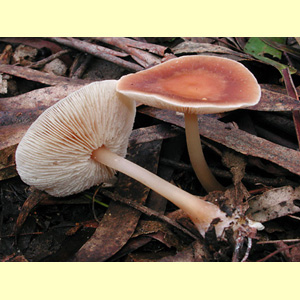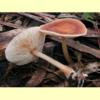
images/Rhodocollybia/rhodocollybia_butyracea_group.jpg
Medium to large agaric, growing on the ground or in litter or mulch, with a cream to yellow, pale pink or pinkish brown spore print. Pileus brown, rarely red or pink, not viscid but often greasy to touch (like butter). Lamellae free, adnexed or sinuate or notched. Stipe central, often much broader towards the base. Partial veil remnants absent. Spores hyaline, dextrinoid (often most obvious in shed spores caught on the pileus, which are also often thick-walled), rarely non-amyloid, smooth; germ pore absent. Cheilocystidia present or absent. Lamellar trama regular or interwoven. Pileipellis a cutis of smooth, unbranched hyphae (very rarely some diverticulate). Clamp connections present.
Pluteus has a pinkish brown spore print and free lamellae, but it usually grows on wood (sometimes on mulch) and has a pileipellis that can be a cutis, trichoderm or hymeniderm. In addition, cystidia are often metuloid and the spores are not dextrinoid.
Entoloma,
Lepista and
Clitopilus morphogroup Rhodocybe also share the pinkish brown spore print, but in the first genus the spores are distinctly angular, in the second warty, and in the third angular in polar view and warty. Similar-shaped agarics to
Rhodocollybia occur in
Gymnopus and
Marasmius. Neither of those genera, however, have a pinkish spore print or dextrinoid spores, and the stipe is often villous, or black below. The pileipellis in
Gymnopus often has branched hyphae, while in
Marasmius it is hymeniform. The few larger species of
Mycena are mostly in
Mycena section Calodontes and are unusual in
Mycena in having smooth pileipellis hyphae. However, they differ from
Rhodocollybia in the white spore print and amyloid (or sometimes non-amyloid) spores. Most other species of
Mycena have amyloid spores, and the hyphae of the pileipellis are typically nodulose.
Rhodocollybia Singer, Schweiz. Z. Pilzk. 17: 71 (1939).
One or a few species: Australian material is placed under Rhodocollybia butyracea for the moment.
W.A., S.A., Vic. and Tas. (and probably also N.T., Qld and N.S.W.).
In native forests and in pine plantations.
On the ground or litter.
Saprotrophic.
Bougher, N.L. (2009a),
Fungi of the Perth region and beyond: a self-managed field book, Western Australian Naturalists' Club (Inc.), Perth. [
Description and
Illustration of
Rhodocollybia sp. (not typical of this genus, may be a
Lepista)]
Bougher, N.L. & Syme, K. (1998), Fungi of Southern Australia. University of Western Australia Press, Nedlands. [Description, Illustration and Microcharacters of Rhodocollybia sp., as Collybia aff. dryophila (this taxon belongs in Rhodocollybia rather than Gymnopus because of the dextrinoid spores)]
Breitenbach, J. & Kränzlin, F. (eds) (1991), Fungi of Switzerland. Volume 3. Boletes and Agarics 1st part. Edition Mykologia, Lucerne. [Illustration, Description and Microcharacters of several species of Rhodocollybia from Europe, including R. butyracea (all as Collybia), but note that most of the species under Collybia belong in Gymnopus]
Fuhrer, B. (2005), A Field Guide to Australian Fungi. Bloomings Books, Hawthorn. [Description and Illustration of R. butyracea]
Halling, R.E. (2009), A revision of Collybia s.l. in the northeastern United States and adjacent Canada. [Key, Descriptions, Illustrations and Microcharacters for five species of Rhodocollybia from North America, including R. butyracea] McCann, I.R. (2003), Australian Fungi Illustrated. Macdown Productions, Vermont. [Illustration of R. butyracea (as Collybia)]



